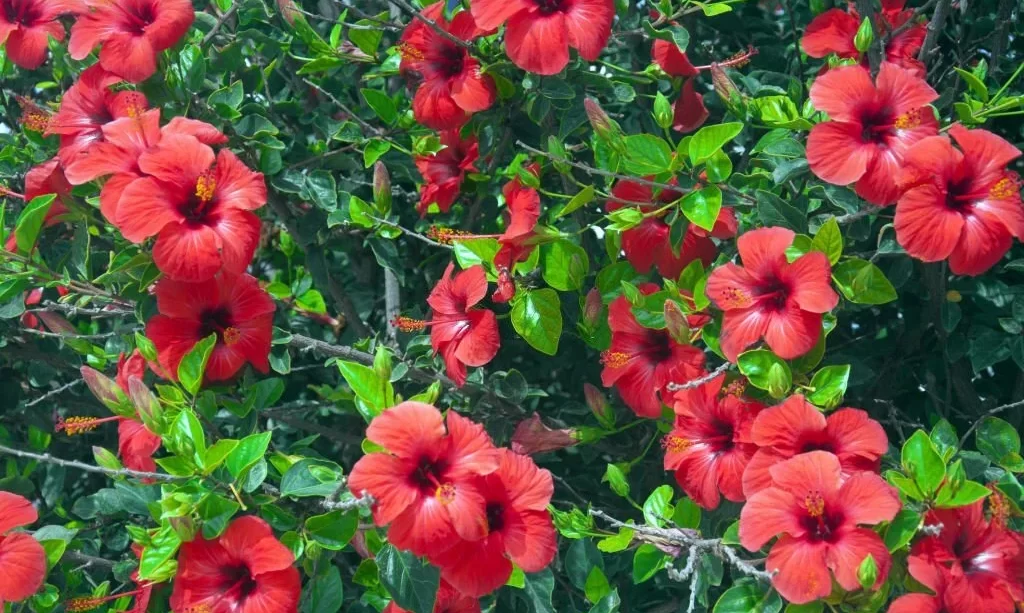Welcome to the enchanting world of hibiscus plants! These vibrant and eye-catching flowers have a special place in the hearts of garden enthusiasts. But before we explore how fast they grow, let’s start at the beginning. Hibiscus isn’t just one plant; it comes in various flavors, or rather, varieties. Each type brings its unique charm to your garden, and knowing these varieties is the first step in understanding their growth.
- HEALTHY SEEDS: 100+ Seeds of Hibuscus. Mixed Colors
- HUGE BLOOMS: Huge Vibrant Flowers, Amazing, Attractive and Humming Bird and Butterfly Friendly
- MADE IN USA. Hand packaged and Shipped for CZ Grain. From Iowa.
- EXOTIC FLOWERS: People give these exotic plants a second look. 100 Rare Garden Flower Seeds
- Satisfaction Guaranteed. Message us if there are any issues for a fast and easy solution. CZ Grain specializes in exotic and rare plants to grow.
Hibiscus Varieties
Hibiscus, like a box of assorted chocolates, offers a delightful array of choices. Here, we’ll introduce you to some of the most common hibiscus varieties:
- Tropical Hibiscus (Hibiscus rosa-sinensis): These are the exotic divas of the hibiscus family, known for their large, showy flowers in shades of red, pink, orange, and even yellow. Tropical hibiscus varieties thrive in warm climates and can be grown in pots.
- Hardy Hibiscus (Hibiscus moscheutos): If you’re in a region with cold winters, hardy hibiscus is your go-to choice. These hardy souls produce stunning, dinner-plate-sized blooms in colors like white, pink, and red. They can withstand chilly temperatures and come back year after year.
- Native Hibiscus: Depending on your location, you might have native hibiscus species. These local heroes are adapted to your region’s specific conditions, making them a great choice for a fuss-free garden.
- Rose of Sharon (Hibiscus syriacus): These hibiscus shrubs are known for their elegant, bell-shaped flowers in various hues. They’re perfect for adding a touch of elegance to your landscape.
- Double Bloom Hibiscus: Imagine a hibiscus flower, and then double it! That’s what you get with double bloom hibiscus varieties. They boast a profusion of petals, making them look like living rosettes.
Now that you’ve got a glimpse of the hibiscus family tree, let’s dig deeper into how these varieties grow and thrive.
Factors Affecting Growth
Hibiscus growth is like a delicate dance with nature, influenced by several factors. To understand their growth speed, it’s crucial to grasp these key influencers:
- Sunlight: Hibiscus are sun-loving plants. They thrive in full sun, which means they need at least 6 to 8 hours of sunlight daily to grow their best. More sun generally equals faster growth.
- Water: Like any living thing, hibiscus need water, but they don’t like soggy feet. Consistent watering, especially during dry spells, is essential. However, soggy soil can hinder their growth, so ensure proper drainage.
- Soil Quality: Good soil is the foundation of healthy growth. Hibiscus prefer well-draining soil that’s rich in organic matter. Amending your soil with compost can work wonders for their growth.
- Temperature: Temperature plays a significant role. Tropical hibiscus varieties enjoy warm climates and grow faster in these conditions. In colder areas, hardy hibiscus can be slower but still steady growers.
- Fertilization: Providing the right nutrients is vital. Hibiscus benefit from balanced fertilizers, with a higher potassium content to boost flowering. Feeding them during the growing season can speed up their growth.
- Sold on Amazon
- Scientifically Formulated for Optimum Plant Growth
- Great for All Hibiscus Varieties
- Contains Fritted Trace Elements
Growth Stages of Hibiscus
Just like humans go through stages of life, hibiscus plants follow a growth journey. Understanding these stages helps in gauging their growth speed:
- Planting Stage: It all begins with a hibiscus cutting or a young seedling. At this stage, growth is relatively slow as the plant establishes its roots. Expect only a few inches of growth in a month or two.
- Vegetative Growth: As your hibiscus settles in, it enters a phase of rapid vegetative growth. During this period, which can last a few months to a year, you’ll see more significant height and bushier foliage.
- Flowering Stage: The real magic happens when your hibiscus starts blooming. The plant continues to grow during this phase, but the focus shifts to producing those stunning, colorful flowers. The speed of growth may vary, but the rewards are worth it.
- Mature Stage: After a couple of years, your hibiscus reaches maturity. At this point, growth slows down, and you’ll notice fewer new branches. However, it continues to produce beautiful blooms if cared for properly.
Understanding these stages and the factors that affect hibiscus growth will help you nurture these plants effectively, whether you’re looking for a burst of rapid growth or steady long-term beauty in your garden.
Typical Growth Rate
Hibiscus growth, like a slow and steady race, can vary depending on various factors. Here’s a glimpse of what you can typically expect in terms of growth rate:
On average, hibiscus plants can grow about 1 to 2 feet in height per year under ideal conditions. This means that during their active growing season, which is usually spring and summer, you can witness a noticeable increase in their height and overall size.
However, it’s important to note that the growth rate may vary among different hibiscus varieties and in different climates. Tropical hibiscus, with their love for warmth and sun, tend to grow faster in suitable conditions. Hardy hibiscus, on the other hand, may have a slightly slower growth rate, especially in cooler regions.
Remember that hibiscus growth is not just about height; it’s also about the lushness of foliage and the profusion of flowers. Proper care and attention to their needs can help you achieve the best growth rates for your hibiscus plants.
Tips for Faster Growth
If you’re eager to see your hibiscus plants grow faster and flourish, here are some tips to give them a boost:
- Provide Ample Sunlight: Ensure your hibiscus gets plenty of sunlight, ideally 6 to 8 hours a day. If you can, place them in a sunny spot in your garden.
- Water Wisely: Keep the soil consistently moist but not waterlogged. Deep, infrequent watering is better than shallow, frequent watering. A layer of mulch helps retain moisture.
- Fertilize Regularly: Feed your hibiscus with a balanced, slow-release fertilizer during the growing season (spring and summer). High-potassium fertilizers can promote flowering.
- Prune Strategically: Pruning encourages new growth. Trim back leggy branches and spent flowers to encourage bushier growth and more blooms.
- Pest and Disease Management: Keep an eye out for pests and diseases, as they can slow growth. Treat any issues promptly to minimize their impact.
- Choose the Right Variety: Select hibiscus varieties that are known for faster growth, especially if you’re in a hurry to see results.
- Warmth and Protection: If you’re in a colder climate, consider planting hibiscus in containers that you can bring indoors during the winter months to protect them from frost.
By following these tips and understanding the factors that influence hibiscus growth, you can help your hibiscus plants thrive and reach their full potential in no time.
- PREMIUM INDOOR + OUTDOOR ORGANIC TROPICAL FLOWER FERTILIZER — Boosts flower production, root growth & blossom color vibrancy for Hibiscus, Bougainvillea, Plumeria (Frangipani / Lei plant), Anthurium, Lantana, Crocosmia, Heliconia, Bird of Paradise, Blood Lily, Passion Flower, Plumbago, Jasmine (Ixora), & other tropical plants.
- NO MESSY LIQUIDS / NO CONFUSING MEASURING SPOONS / NO STINKY SMELL — 1 tube = 100 concentrated EarthPods (a 4-year supply for a single special tropical Hibiscus or use on big collection of potted tropical flowers)
- FAST & EASY TO APPLY — Push 1 EarthPod all the way into potting soil mix near center of tropical plant, then just water! (EarthPods break down & slow release nutrients direct to root zone)
- PROPRIETARY FORMULA FOR SUPERIOR RESULTS — Special tropical flower fertilizer robust with a variety of organic plant nutrients, trace minerals, soil life & humates in a form immediately available to your plants
- ECO FRIENDLY & COMPACT — Stores easily on your kitchen shelf + recycle the empty paperboard tube when done (EarthPods are pet, child, eco-friendly + 100% sustainably made in the USA)
Common Growth Challenges
While hibiscus plants are resilient, they can face a few growth challenges along the way. Here are some common issues and how to tackle them:
- Pests: Aphids, mealybugs, and spider mites can bug your hibiscus. Use insecticidal soap or neem oil to keep these tiny troublemakers at bay.
- Diseases: Hibiscus may encounter fungal diseases like powdery mildew or rust. Apply fungicides when needed and ensure good air circulation around your plants.
- Overwatering: Too much water can lead to root rot, slowing down growth. Be mindful of your watering schedule and ensure proper drainage.
- Poor Soil: Inadequate soil quality can stunt growth. Amend your soil with compost to improve its fertility and drainage.
- Nutrient Deficiency: If your hibiscus leaves turn yellow, it might be a sign of nutrient deficiency. Feed them with a balanced fertilizer to address this issue.
- Extreme Weather: Hibiscus can struggle in extreme heat or cold. Protect them during harsh weather conditions with shade or frost covers.
Conclusion
In the world of gardening, hibiscus plants are like the vibrant stars of the show. Their growth journey is a fascinating one, influenced by factors like sunlight, water, and care. While the typical growth rate is about 1 to 2 feet per year, remember that patience is the key to nurturing these beauties.
By understanding the growth stages, factors affecting growth, and the challenges they might face, you can become a skilled hibiscus gardener. Whether you’re aiming for a burst of rapid growth or a steady, long-lasting bloom, your hibiscus will reward your care and attention with their stunning flowers and lush green foliage. So, get ready to enjoy the delightful journey of hibiscus gardening in your own backyard!






